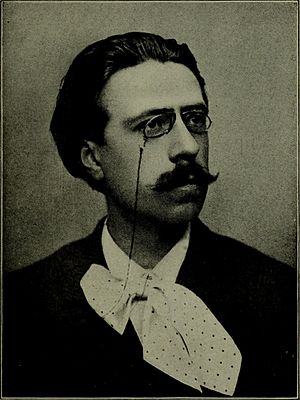Paul Gilson facts for kids
Paul Gilson was a famous Belgian musician and composer. He was born in Brussels on June 15, 1865, and passed away there on April 3, 1942.
Contents
Early Life and Training
Paul Gilson was born in Brussels, Belgium. When he was one year old, his family moved to Ruisbroek. There, he started learning music theory from Auguste Cantillon, who was an organist. Paul also began writing music for orchestras and choirs.
He later studied at the Brussels Conservatory from 1887 to 1889. He learned composition from François-Auguste Gevaert. In 1889, he won the Belgian Prix de Rome. This was a special award for his musical piece called Sinaï. Winning this prize allowed him to travel and study music in other countries. He visited Bayreuth (Germany) in 1892, Paris (France) in 1893–1894, and Italy in 1895.
Becoming a Famous Composer
Paul Gilson became well-known after his large orchestral work, La mer (The Sea), was first performed. This happened in Brussels on March 20, 1892. This piece made him famous in Belgium and in other countries, though not in Paris.
In 1899, he became a professor of composition at the Brussels Conservatory. He also taught at the Antwerp Conservatory starting in 1904. However, he left both teaching jobs in 1909. This was because he became an inspector of music education. He held this important role until 1930.
Even though he wrote a lot of music, he composed less after 1905. Instead, Gilson started writing more about music itself. He wrote about music theory, criticized musical works, and discussed composition.
Musical Group and Writings
In 1925, some of Gilson's students formed a group called Les Synthétistes. This group included composers like Marcel Poot and Maurice Schoemaker. They followed Gilson's ideas about music.
Along with Poot and Schoemaker, Gilson started a music magazine called La revue belge musicale in 1924. He was the main editor until the magazine stopped publishing in 1939. He also wrote short articles for Belgian radio. Gilson often wrote letters to Russian composers César Cui and Mitrofan Belyayev.
Musical Style and Important Works
Paul Gilson's music was somewhat traditional. Some of his pieces were influenced by the composer Wagner. Gilson's books on music theory and how to use instruments also show this influence.
His most successful work was La Mer (The Sea). This piece has four parts, like "symphonic sketches," that describe the sea. It was meant to go along with poems by Eddy Levis. Many people think it tells a story about the sea. Gilson's La Mer was created ten years before another famous piece with the same name by Claude Debussy.
While his later works, like the oratorio Francesca da Rimini, were well-made, they sometimes lacked the fresh ideas found in La Mer. One special piece that stood out was Variations symphoniques. This work was originally written for a brass band and is one of his few major pieces without a story behind it.
Honours
- 1932: He was made a commander in the Order of Leopold. This is a high honor in Belgium.
Selected Works
Paul Gilson wrote many different types of music. Here are some examples:
For Orchestra
- 1890 Alla Marcia (a lively piece for string orchestra)
- 1892 La Mer (The Sea) – his famous four symphonic sketches:
- Lever de soleil (Sunrise)
- Chants et danses de matelots (Sailors' Songs and Dances)
- Crépuscule (Twilight)
- Tempête (Storm)
- 1903 Variations symphoniques (Symphonic Variations) – a major work for a large orchestra.
For Wind Orchestra
- 1891 Fantaisie canadienne (Canadian Fantasy)
- 1903 Variation symphonique (Symphonic Variation) for brass instruments
- 1930 Grande marche du Centenaire (Grand Centennial March)
Stage Works
- 1892 Francesca da Rimini – a dramatic story told with music for singers, choir, and orchestra.
- 1896–1900 La captive (The Captive) – a ballet.
- 1903 Princesse Rayon de Soleil (Princess Sunshine) – a fairy tale play with music.
Other Works
- 1902 Petite suite rustique (Little Rustic Suite) for piano.
- 1926 Sonatina for carillon (a musical instrument with bells).
Books and Writings
- 1913 Le Tutti orchestral (about the full orchestra)
- 1923 Traité d'harmonie (Treatise on Harmony) – a book about how musical notes fit together.
- 1942 Notes de musique et souvenirs (Music Notes and Memories) – his own memoirs.
See also
 In Spanish: Paul Gilson para niños
In Spanish: Paul Gilson para niños


